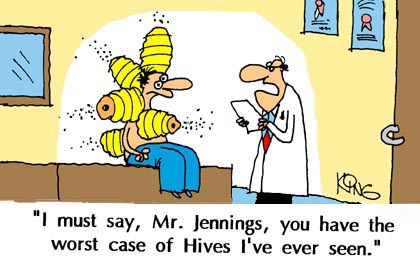
Overview
Hives, also know as urticaria, are red, itchy, raised welts on the skin and are usually caused by an allergy. They can occur due to food allergies, seasonal allergies, or allergies to certain medications or other substances, or for other unknown reasons not relating to allergies. Hives can appear any where on the body, including the face, arms, legs, lips, head, and neck.
Causes
Usually hives are caused by allergies, but they may also occur as a result of other medical conditions, such as Epstein-Barr, HIV, or Hepatitis. One common cause of hives is allergic reactions to medication. If symptoms occur soon after starting a new medication, it is likely that the medication is causing the problems. Other causes of hives may be due to recent dietary changes, new shampoos, conditioners, or skin products, or because of a recent move. Hives usually appear suddenly and can last for up to 24 hours before fading, but may reappear if the source of the problem is not fixed. If the hives do not go away after six weeks, it is considered to be chronic urticaria. Likewise, hives that last less than six weeks are diagnosed as acute urticaria. Hives are considered very common with over 3 million cases reported annually (Mayo Clinic).
Treatment
The best treatment for hives is avoidance of the substance that is causing the reaction. However, this is not always possible if the substance is something that can’t be avoided or even identified. Antihistamines can lessen symptoms but steroids may be needed if symptoms persist. Allergy testing is usually not needed for hives because the source of the allergy is usually something that can be eliminated. However, if there is no obvious cause of the allergic reaction and the symptoms can’t be eliminated with antihistamines or steroids, then allergy testing and treatment may be needed.
